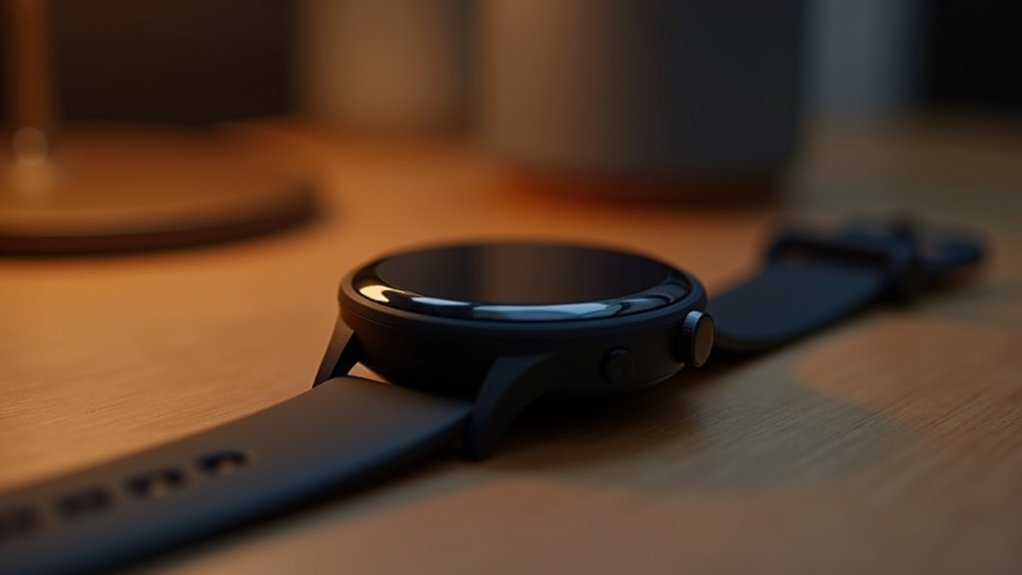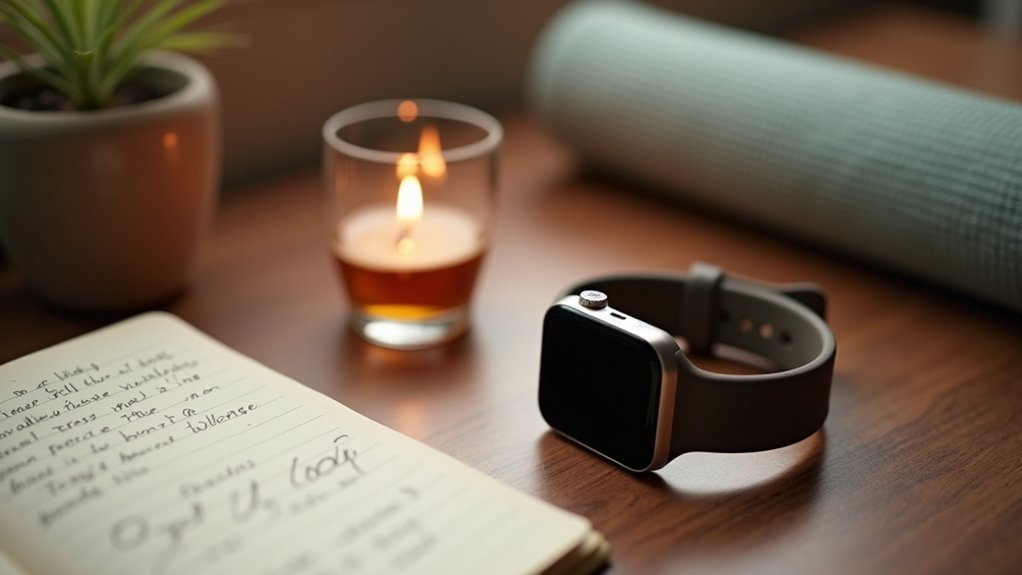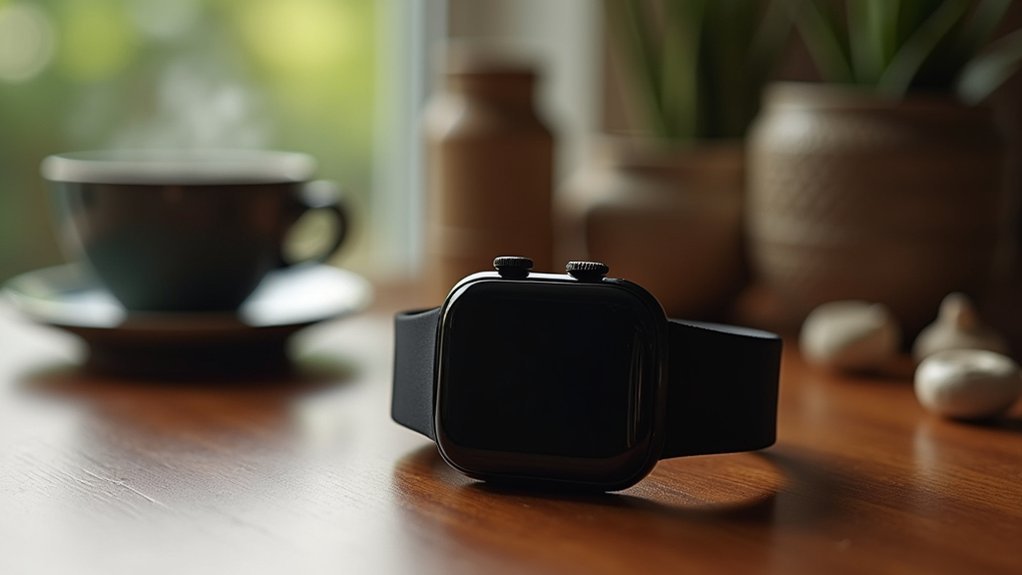For accurate stress tracking, chest straps like the Polar H10 offer medical-grade precision, while smartwatches such as Fitbit Sense 2 and Apple Watch Series 8 provide versatile health metrics. The WHOOP 5.0 and OURA Ring offer distraction-free monitoring for minimalists. Budget options include basic Fitbit models and Xiaomi smartwatches. Your ideal device should track heart rate variability (HRV), as it’s the primary physiological indicator of stress. Discover how these wearables can transform your stress management approach below.
Understanding How Wearables Detect Stress Physiologically

While stress has always been part of human experience, modern wearable technology now allows us to track and understand it through precise physiological measurements. Your body exhibits several measurable reactions when stressed, with heart rate variability (HRV) being the primary indicator wearables track.
Wearable tech transforms our understanding of stress by measuring the body’s physiological responses in real time.
When you’re stressed, your HRV decreases as your sympathetic nervous system activates. Smart watches and bands capture this alongside other essential indicators like electrodermal activity (skin conductance), respiratory patterns, and skin temperature. Traditional stress assessment methods like questionnaires face challenges due to their subjective nature, making physiological monitoring increasingly valuable.
More advanced devices like Empatica wristbands and Emotiv headwear monitor multiple signals simultaneously, creating a thorough stress profile.
These devices use sensors to collect your physiological data, which is then processed through machine learning algorithms that can distinguish stress states from normal functioning, enabling real-time stress monitoring.
Top Heart Rate Monitors for Real-Time Stress Detection
The marketplace of stress-tracking wearables offers diverse options for monitoring your body’s response to daily pressures. Your choice ultimately depends on accuracy needs versus comfort and convenience.
For highest precision, chest straps like Polar H10 deliver medical-grade accuracy with 400-hour battery life and compatibility with 200+ apps. Advanced models can measure heart rate variability to provide deeper insights into your body’s stress response.
Smartwatches balance functionality with convenience—Fitbit Sense 2 and Apple Watch Series 8 integrate extensive health metrics alongside stress detection.
If you prefer discretion, screenless options like WHOOP 5.0 and OURA Ring track stress markers without distractions.
- Most accurate: Chest straps (Polar H10, Garmin HRM-Pro)
- Most versatile: Smartwatches (Apple Watch, Fitbit Sense 2)
- Most unobtrusive: Screenless wearables (OURA Ring, WHOOP 5.0)
HRV Tracking: The Science Behind Stress Measurement

Heart rate variability (HRV) serves as the cornerstone of modern stress detection technology, revealing what your heart rate alone cannot. This metric measures the fluctuation between your heartbeats, directly reflecting how your autonomic nervous system responds to stress.
When you’re stressed, your sympathetic nervous system activates, reducing HRV, while relaxation triggers parasympathetic activity that increases HRV. The hypothalamus processes signals from these autonomic nervous system components to regulate various bodily functions in response to stress. Wearables capture this data through ECG or PPG sensors, then analyze it using metrics like RMSSD and the LF/HF ratio.
Your device’s ability to track HRV offers valuable insights into your body’s stress response. A consistently low HRV might indicate chronic stress, while improvements suggest better resilience.
Budget-Friendly Wearables With Stress Monitoring Capabilities
Why spend hundreds on premium trackers when budget-friendly wearables can effectively monitor your stress levels? Many affordable devices now offer heart rate monitoring alongside basic stress tracking features through heart rate variability (HRV) or guided breathing exercises.
Options worth considering include:
- Basic Fitbit Models – Provide stress tracking through guided breathing exercises and continuous heart rate monitoring.
- Xiaomi Devices – Offer affordable smartwatches with phone connectivity and basic stress assessment features.
- WHOOP 5.0 Band – Delivers continuous heart rate monitoring and recovery metrics that indirectly help with stress assessment.
While budget devices may lack the advanced features of premium options, they still deliver reliable heart rate tracking and basic stress monitoring capabilities at a fraction of the cost. The COOSPO Rechargeable Chest Heart Rate Monitor is another excellent budget option offering waterproof capabilities and impressive 50-hour battery life for consistent tracking.
Premium Stress Tracking Features Worth the Investment
While budget options provide basic stress tracking features, premium wearables offer sophisticated monitoring capabilities that can transform how you understand and manage your physiological responses to stress. These high-end devices incorporate advanced sensors like electrodermal activity (EDA) monitors and detailed HRV analysis that provide deeper insights into your stress patterns. Some premium wearables like WHOOP provide valuable insights on stress impacts through continuous monitoring of physiological metrics.
| Premium Feature | Benefit |
|---|---|
| EDA Sensors | Detect subtle skin conductance changes signaling stress |
| Advanced HRV Analysis | Provides detailed stress metrics throughout the day |
| Breathing Rate Sensors | Track respiratory patterns during stress episodes |
| PTT Monitoring | Estimates blood pressure fluctuations from stress |
| Continuous Monitoring | Identifies stress triggers with 24/7 data collection |
You’ll get thorough app interfaces that interpret these metrics, offering personalized recommendations rather than just raw data.
Sleep Quality Monitoring as a Stress Indicator
Your wearable can reveal how stress disrupts REM sleep patterns, which directly impacts your mental recovery and emotional regulation.
Modern devices track your nighttime heart rate variability (HRV), providing essential insights into your autonomic nervous system’s ability to manage stress during sleep.
Research indicates that prolonged stress exposure can significantly predict sleep quality, with stress-induced hormonal responses like cortisol and adrenaline directly interfering with normal sleep regulation mechanisms.
REM Sleep Stress Connection
The intricate relationship between REM sleep and stress provides a powerful window into how our bodies respond to psychological pressure.
When you experience stress, your REM sleep patterns shift markedly—acute stress typically triggers a rebound increase of up to 63%, while prolonged stress can prevent this recovery mechanism altogether.
Modern wearables can detect these telltale changes in your sleep architecture:
- Fragmented REM sleep patterns may indicate ongoing stress, potentially predicting vulnerability to conditions like PTSD or depression.
- Microarousals during REM detected by heart rate variability measurements reveal stress-induced sleep disruptions.
- Changes in REM duration relative to total sleep time offer insights into your body’s stress hormone regulation.
Polysomnographic studies consistently demonstrate that patients with PTSD experience significant REM sleep fragmentation throughout the night.
Tracking these patterns gives you valuable data about how effectively your body processes and recovers from daily stressors.
Nighttime HRV Tracking
Nighttime heart rate variability (HRV) offers perhaps the most significant window into your body’s stress response during sleep. High HRV indicates better recovery and overall health, while low readings suggest your body remains in a stressed state overnight.
Devices like Apple Watch with the SleepWatch app can track your HRV throughout sleep cycles, while non-wearable options like EMFIT QS gather data without requiring you to wear anything. For ideal results, measure your HRV consistently—ideally every morning.
Your HRV fluctuates between sleep stages, providing insights into sleep quality and recovery status. By monitoring these patterns over time, you’ll identify stressors affecting your rest and can adjust routines accordingly. Average Sleeping HRV is controlled by the autonomic nervous system which responds to various environmental stimuli affecting your overall health and stress responses.
Many apps now offer personalized recommendations based on your HRV data to improve both sleep and stress management.
Sleep-Stress Cycle Analysis
Building on HRV measurements, an extensive sleep-stress cycle analysis reveals how these two biological processes influence each other in a continuous feedback loop.
Modern wearables track metrics that establish clear connections between your sleep quality and stress levels, offering actionable insights.
Research shows that each additional hour of sleep decreases your odds of moderate-to-high stress by approximately 38%, while elevated resting heart rates directly correlate with increased stress. The groundbreaking LEMURS project initiated in 2022 is providing valuable data on these connections by tracking college students’ health using biosensors.
Devices like the Oura Ring and various wrist-worn wearables continuously monitor these patterns unobtrusively.
- Physiological indicators – HRV, respiratory rate, and resting heart rate provide objective stress measurements during sleep
- Continuous monitoring – Tracks patterns over time, establishing your personal baseline and variations
- Predictive capability – Can identify stress biomarkers before you subjectively feel their effects
Comparing Wearable Accuracy in High-Stress Situations
When analyzing wearable devices for stress tracking, accuracy becomes particularly essential in high-stress situations. All devices struggle during high-intensity exercises due to motion artifacts, with accuracy considerably diminishing as your heart rate increases.
Apple Watch and Fitbit perform reasonably well at lower intensities but lose reliability when your heart rate exceeds 150 bpm. Garmin excels in HRV monitoring, while Polar offers strong HR tracking despite facing similar high-intensity challenges.
For clinical-grade monitoring, Empatica provides superior physiological signal collection.
Heart Rate Variability remains a more reliable stress indicator than heart rate alone. If you’re monitoring stress during exercise or high-pressure situations, consider that device performance varies between normal heart rhythms and conditions like atrial fibrillation, where accuracy further decreases. Research shows a significant difference in accuracy with mean absolute difference at peak exercise being 13.8 bpm for normal rhythm versus 28.7 bpm for atrial fibrillation.
Integrating Breathing Exercises With Heart Rate Data
Modern wearable devices now seamlessly integrate breathing exercises with heart rate monitoring, creating a powerful combination for stress management. Your smartwatch can guide you through diaphragmatic breathing using tactile feedback while simultaneously tracking your heart rate to show real-time effectiveness. According to studies, this integration has contributed to a 30% increase in overall well-being among early users within six weeks.
This synchronization optimizes breathing to about six breaths per minute, which research shows maximizes stress-reduction benefits.
- Wearables provide personalized breathing recommendations based on your specific heart rate variability (HRV) and stress patterns.
- Real-time biofeedback helps you improve your technique and track progress over time.
- Devices like Polar’s Serene feature deliver guided exercises that adapt to your physiological responses.
With consistent practice, you’ll notice improved stress resilience, better sleep quality, and increased overall well-being as you train your body to respond effectively to stressors.
Wearables That Connect Stress Levels to Daily Activities
Today’s sophisticated wearables go beyond simple heart rate tracking by establishing clear connections between your stress levels and specific daily activities. Using advanced algorithms and multiple sensors, devices from Fitbit, Garmin, and Apple Watch analyze how your daily routine impacts your physiological stress response. While these devices provide valuable insights, they should not replace FDA-approved medical devices for monitoring health conditions that require greater accuracy.
| Activity Type | Stress Impact | Tracking Method |
|---|---|---|
| Exercise | Differentiated from emotional stress | HRV + motion sensors |
| Cognitive Tasks | Measured mental strain | ECG + blood pressure |
| Sleep Quality | Long-term stress influence | SpO2 + sleep cycle |
These platforms don’t just collect data—they provide actionable insights. When your watch detects elevated stress during meetings or commutes, you’ll receive personalized recommendations. The integration of machine learning means your device becomes increasingly accurate at distinguishing between good stress (exercise) and harmful stress (environmental or social stressors).
Mobile Apps That Enhance Wearable Stress Tracking Features
While wearable devices provide the hardware foundation for stress tracking, mobile applications serve as the interpretive layer that transforms raw biometric data into meaningful insights.
These apps work seamlessly with devices like Apple Watch and Fitbit to offer extensive stress management solutions.
- HRV-Based Analytics: Apps like Stress Monitor and Welltory utilize heart rate variability to quantify stress levels, with Welltory offering personalized management plans based on your lifestyle and data patterns. The HRV Tracker app analyzes body signals to provide insights into your mental and emotional performance throughout the day.
- Real-Time Intervention: When elevated stress is detected, apps can immediately suggest breathing exercises, with Fitbit’s guided sessions showing a 45% reduction in physiological stress markers.
- Mindfulness Integration: Calm and Headspace enhance wearable functionality by providing targeted meditation sessions, with Calm users reporting a 60% decrease in anxiety through consistent practice.
Frequently Asked Questions
Can Stress Tracking Wearables Help With Diagnosed Anxiety Disorders?
Yes, stress tracking wearables can help with your diagnosed anxiety disorder. They monitor HRV to detect stress, provide real-time feedback, and guide you through breathing exercises to regulate your nervous system during anxiety episodes.
How Long Do Stress-Tracking Wearable Batteries Typically Last?
Most stress-tracking wearable batteries last 1-7 days depending on the device. Your Garmin Vivosmart 5 offers up to 7 days, while Apple Watch typically needs daily charging. Screen usage and notification settings impact battery life.
Are Waterproof Stress Trackers Effective During Swimming or Sauna Use?
Waterproof stress trackers work in saunas but have limited accuracy when swimming. You’ll get basic data underwater, but for precise heart rate monitoring, consider using a chest strap instead of wrist-based sensors.
Do Wearables Cause Skin Irritation With Continuous Stress Monitoring?
Yes, continuous stress monitoring wearables can cause skin irritation. You’ll reduce risk by choosing ISO 10993-compliant materials, ensuring proper fit, cleaning regularly, taking breaks, and using devices with hydrogel electrodes or ergonomic designs.
Can Employers Access Stress Data From Employee Wellness Program Wearables?
Yes, employers can access your stress data from wellness program wearables, but they must follow strict legal guidelines including obtaining your informed consent, ensuring job relevance, and maintaining data confidentiality to avoid potential liability.
In Summary
You’ll find today’s stress-tracking wearables offer unprecedented insight into your body’s response to daily pressures. Whether you choose a budget-friendly option or invest in premium features, these devices help you understand when stress is affecting your health. By monitoring your heart rate and HRV patterns, you’re equipped to make meaningful lifestyle changes. Remember that the best device is one you’ll wear consistently as you build better stress management habits.





Leave a Reply